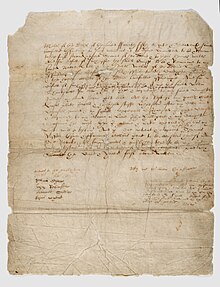Secretary hand


Secretary hand or script is a style of European handwriting developed in the early sixteenth century that remained common in the sixteenth and seventeenth centuries for writing English, German, Welsh and Gaelic.[1]
History
[edit]Predominating before the dominance of Italic script, it arose out of the need for a hand more legible and universally recognizable than the book hand of the High Middle Ages, in order to cope with the increase in long-distance business and personal correspondence, in cities, chanceries and courts. The hand thus used by secretaries was developed from cursive business hands and was in common use throughout the British Isles through the seventeenth century. In spite of its loops and flourishes it was widely used by scriveners and others whose daily employment comprised hours of writing. By 1618 the writing-master Martin Billingsley in his The Pen's Excellency, 1618,[2] distinguished three forms of secretary hand, as well as "mixed" hands that employed some Roman letterforms, and the specialised hands, the "court hand" used only in the courts of the King's Bench and Common Pleas and the archaic hands used for engrossing pipe rolls and other documents.

At the time of Henry VII, many writers began to use the "Italian" style instead, a cursive script developed from the humanist minuscule or "Roman" hand which was easier to read but also easier to forge. English ladies were often taught an "Italian hand", suitable for the occasional writing that they were expected to do.[4] Grace Ioppolo notes[2] that the convention in writing the texts of dramas was to write act and scene settings, characters' names and stage directions in italic, and the dialogue in secretary hand. The modern use of italic font stems from these distinctions.[citation needed]
Aside from palaeographers themselves, genealogists, social historians and scholars of Early Modern literature have become accustomed to reading secretary hand.[5][6]
See also
[edit]- Bastarda – Blackletter script used in France and Germany
- Blackletter – Historic European script and typeface
- Book hand – Legible handwriting style
- Calligraphy – Visual art related to writing
- Chancery hand – Any of several styles of historic handwriting (used in the records of the Court of Common Pleas)
- Court hand – Style of handwriting used in medieval English law courts (also known as law hand, Anglicana, cursiva antiquior, or charter hand)
- Cursive – Style of penmanship
- Hand (writing style) – Style of handwriting
- Handwriting – Writing created by a person with a writing implement
- History of writing
- Italic script – Style of handwriting and calligraphy developed in Italy
- Palaeography – Study of handwriting and manuscripts
- Penmanship – Technique of writing with the hand
- Ronde script (calligraphy)
- Rotunda (script) – Medieval blackletter script
- Round hand – Type of handwriting
References
[edit]Notes
[edit]- ^ Scottish handwriting: Secretary hand: one hour basic tutorial.
- ^ a b Ioppolo 2010, p. 177.
- ^ Shakespeare, Hamilton & Fletcher 1994, pp. 131–33.
- ^ Ioppolo 2010, pp. 178f.
- ^ Genealogy: Secretary hand at the Wayback Machine (archived 2 December 2010)
- ^ "Secretary hand". The Pen Room. University of Leicester. Archived from the original on 1 March 2011.
Bibliography
[edit]- Shakespeare, William; Hamilton, Charles; Fletcher, John (1994). Cardenio, Or, the Second Maiden's Tragedy. Glenbridge. ISBN 0-944435-24-6.
- Ioppolo, Grace (2010). "Early modern handwriting". In Michael Hattaway (ed.). A New Companion to English Renaissance Literature and Culture. John Wiley & Sons. ISBN 978-1-4443-1902-6.
- Ison, Alf (1990). A Secretary Hand ABC Book.
- Munby, Lionel M. (1984). Secretary Hand: a beginner's introduction. British Association for Local History.
External links
[edit]- English Handwriting 1500-1700: An Online Course from Cambridge University
- Reading Old Handwriting
- Fonts for Latin Palaeography, A comprehensive PDF file containing 82 pages profusely illustrated. January 2024.

